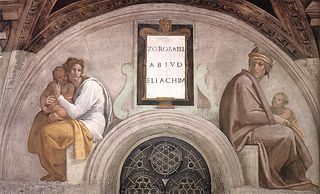
Matthew 1:13 is the thirteenth verse of Matthew 1 of the Gospel of Matthew in the New Testament. The verse is part of the section where the genealogy of Joseph, the father of Jesus, is listed. This verse covers the section somewhat after the Babylonian Captivity six generations before Jesus.

Matthew 1:11 is the eleventh verse of the first chapter of the Gospel of Matthew in the New Testament. The verse is part of the section where the genealogy of Joseph, the father of Jesus, is listed. It is the last verse of the middle third of the listing.

Matthew 1:8 is the eighth verse of the first chapter of the Gospel of Matthew in the New Testament. The verse is part of the section where the genealogy of Joseph, the legal father of Jesus, is listed.

Matthew 1:7 is the seventh verse of the first chapter of the Gospel of Matthew in the New Testament. The verse is part of the section where the genealogy of Joseph, the legal father of Jesus, is listed.
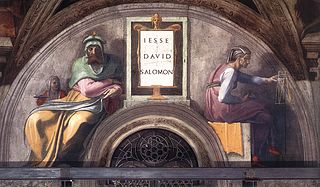
Matthew 1:6 is the sixth verse of the first chapter of the Gospel of Matthew in the New Testament. The verse is part of the section where the genealogy of Joseph, the legal father of Jesus, is listed.
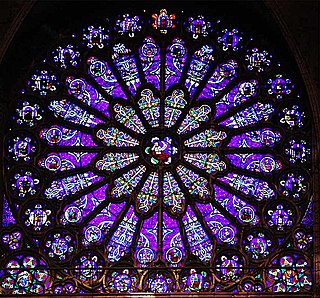
The New Testament provides two accounts of the genealogy of Jesus, one in the Gospel of Matthew and another in the Gospel of Luke. Matthew starts with Abraham, while Luke begins with Adam. The lists are identical between Abraham and David, but differ radically from that point. Matthew has twenty-seven generations from David to Joseph, whereas Luke has forty-two, with almost no overlap between the names on the two lists. Notably, the two accounts also disagree on who Joseph's father was: Matthew says he was Jacob, while Luke says he was Heli.

Matthew 1:5 is the fifth verse of the first chapter in the Gospel of Matthew in the New Testament. The verse is part of the section where the genealogy of Joseph, the legal father of Jesus, is listed.

Matthew 1:4 is the fourth verse of the first chapter in the Gospel of Matthew in the New Testament. The verse is part of the section where the genealogy of Joseph, the legal father of Jesus, is listed.

Matthew 1:3 is the third verse of the first chapter in the Gospel of Matthew in the New Testament. The verse is part of the section where the genealogy of Joseph, the legal father of Jesus, is listed.

Matthew 1:2 is the second verse of the first chapter in the Gospel of Matthew in the New Testament. The verse is the first part of the section where the genealogy of Joseph, the legal father of Jesus, is listed.

Matthew 1:14 is the fourteenth verse of the first chapter of the Gospel of Matthew in the New Testament. The verse is part of the section where the genealogy of Joseph, the father of Jesus, is listed.
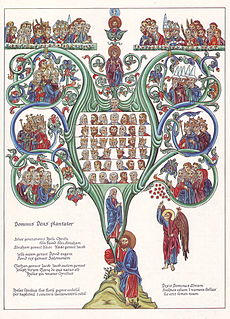
Matthew 1:17 is the seventeenth verse of the first chapter in the Gospel of Matthew in the New Testament. The verse is the conclusion to the section where the genealogy of Joseph, the father of Jesus, is listed.

Matthew 1:15 is the fifteenth verse of the first chapter of the Gospel of Matthew in the New Testament. The verse is part of the section where the genealogy of Joseph, the father of Jesus, is listed.

Matthew 1:25 is the twenty-fifth and last verse of the first chapter of the Gospel of Matthew in the New Testament. Joseph has awakened from a dream in which an angel gave him instructions about the birth of Jesus. He has taken Mary into his home, completing their marriage, and this verse explains what occurs once the couple is united.
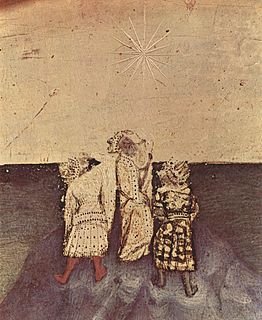
Matthew 2:10 is the tenth verse of the second chapter of the Gospel of Matthew in the New Testament. The magi, dispatched by King Herod, have been shown the location of the infant Jesus by the Star of Bethlehem. In this verse they react to this.
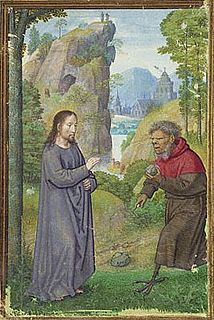
Matthew 4:3 is the third verse of the fourth chapter of the Gospel of Matthew in the New Testament. This verse opens the section in Matthew dealing with the temptation of Christ by Satan. Jesus has been fasting for forty days and forty nights and in this verse the devil gives Christ his first temptation and encourages him to use his powers to get food.

Matthew 5:1 and Matthew 5:2 are the first two verses of the fifth chapter of the Gospel of Matthew in the New Testament. The verses introduce the Sermon on the Mount that will be recited in the next several chapters. The previous verse mentioned the large crowds "from Galilee, and from the Decapolis, Jerusalem, Judea, and beyond the Jordan" who followed Jesus to witness him healing: these verses present Jesus as seeing the crowds and going up onto a mountain to begin teaching.

Shealtiel, transliterated in Greek as Salathiel, was the son of Jeconiah, king of Judah. The Gospel of Matthew 1:12 also list Shealtiel as the son of Jeconiah. Jeconiah, Shealtiel as well as the most of the royal house and elite of Judah were exiled to Babylon by order of Nebuchadnezzar II of Babylon after the first siege of Jerusalem in 597 BC. During the Babylonian captivity, Shealtiel was regarded as the second Exilarch, following his father.
In Bible prophecy, several verses relate to the future of the Davidic line. Christians argue that Jesus fulfills these prophecies, while skeptics and Jews disagree.


























